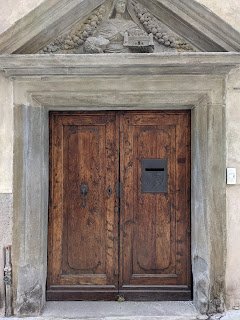What is the 40 Doors Project of Bergamo?
This project showcases interesting doors of Bergamo, Italy. In a series of posts, we'll show 40 different doors per post. And, each post has a theme that connects to doors. This post is the third in the series and its theme are the ideas in the documentary/book "The Ascent of Man".
The Ascent of Man
Not only is the 40 Doors Project about doors of Bergamo, it's also about a few of our favorite things. In the first post, we mention Max Richter (music). In the second post, we mention A Pattern Language (book). In this post, the focus is on one our favorite documentary films, The Ascent of Man (1973), written and presented by British mathematician and historian of science Jacob Bronowski. (The book of the same name is a word-for-word transcription of the video plus additional material.)
Chapter/Episode 3, The Grain in the Stone, discusses tools and the development of architecture and sculpture. One question Bronowski raises is why civilization begin so much later in the New World than in the Old World. Bronowski wanders around Canyon de Chelly in Arizona and discusses the development of the civilization there. A few frames later, he is at Machu Picchu in Peru describing the great Inca architectural wonder.
The answer to his question: man arrived later in the New World, coming across the Bering Straits not later than 10,000 BC and not earlier than 30,000 BC.
Bronowski sits among the ruins of Machu Picchu surrounded by the pillow-like faces of huge granite blocks, perfectly stacked together with mortarless joints in mind-boggling precision. He points out that at the height of the empire around 1500 AD, the Incas were at the same point the Greeks were 2,000 years earlier. In particular, for the Incas and Greeks the beam was a mainstay of construction. The arch wasn't in use (or invented). Bronowski explains:
"Like the mathematics of Peru two thousand years later, The Greek temples were bounded by the straight edge and the set square. The Greeks did not invent the arch either, and therefore their temples are crowded avenues of pillars. They seem open when we see them as ruins, but in fact they are monuments without spaces."
So what does this have to do with doors? Well, we couldn't help but notice the use of the arch in so many doors we photographed, and variations thereof. Bronowski mentions that the ancient Romans where the first to widely apply the use of the arch, but they didn't invent it.
The arches in these door photos vary in the details, but many have what's called an impost, serving as the base from which the arch starts. There are different arches: gothic or ogive, semi-circular, horseshoe, Tudor, and corbel to name a few. The majority of arches in these photos are semi-circular or round. Arches framing a door look more pleasing, especially on larger buildings. Why this is the case, we don't know. We wish we could ask Bronoswki.









































No comments:
Post a Comment
All comments are moderated. If your comment doesn't appear right away, it was likely accepted. Check back in a day if you asked a question.